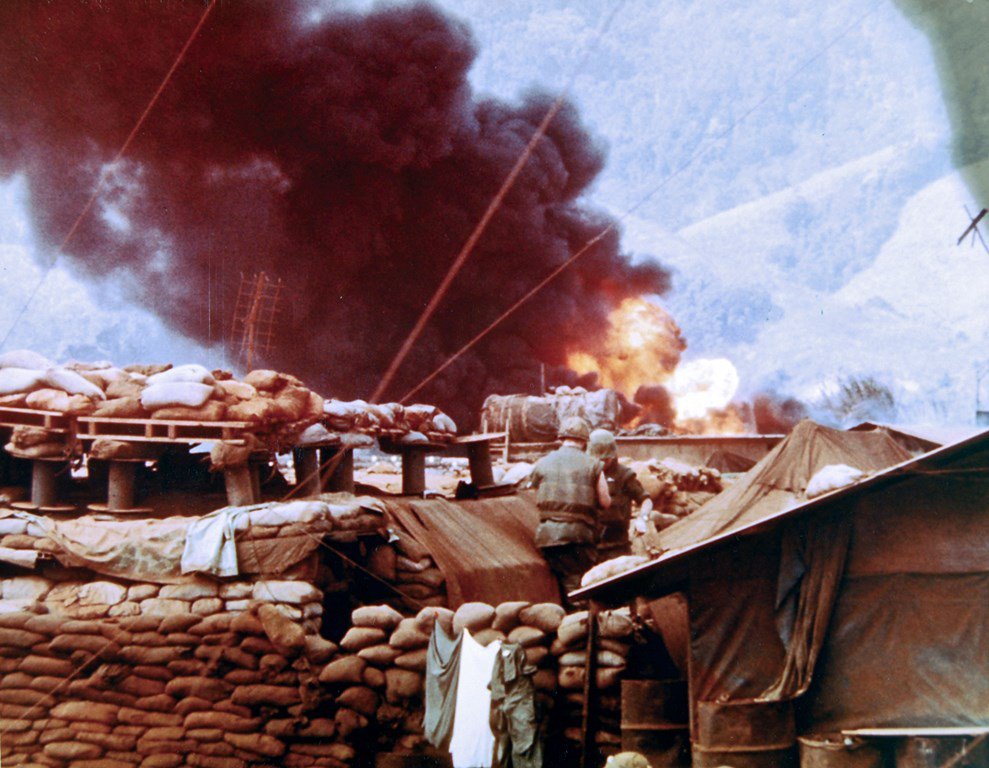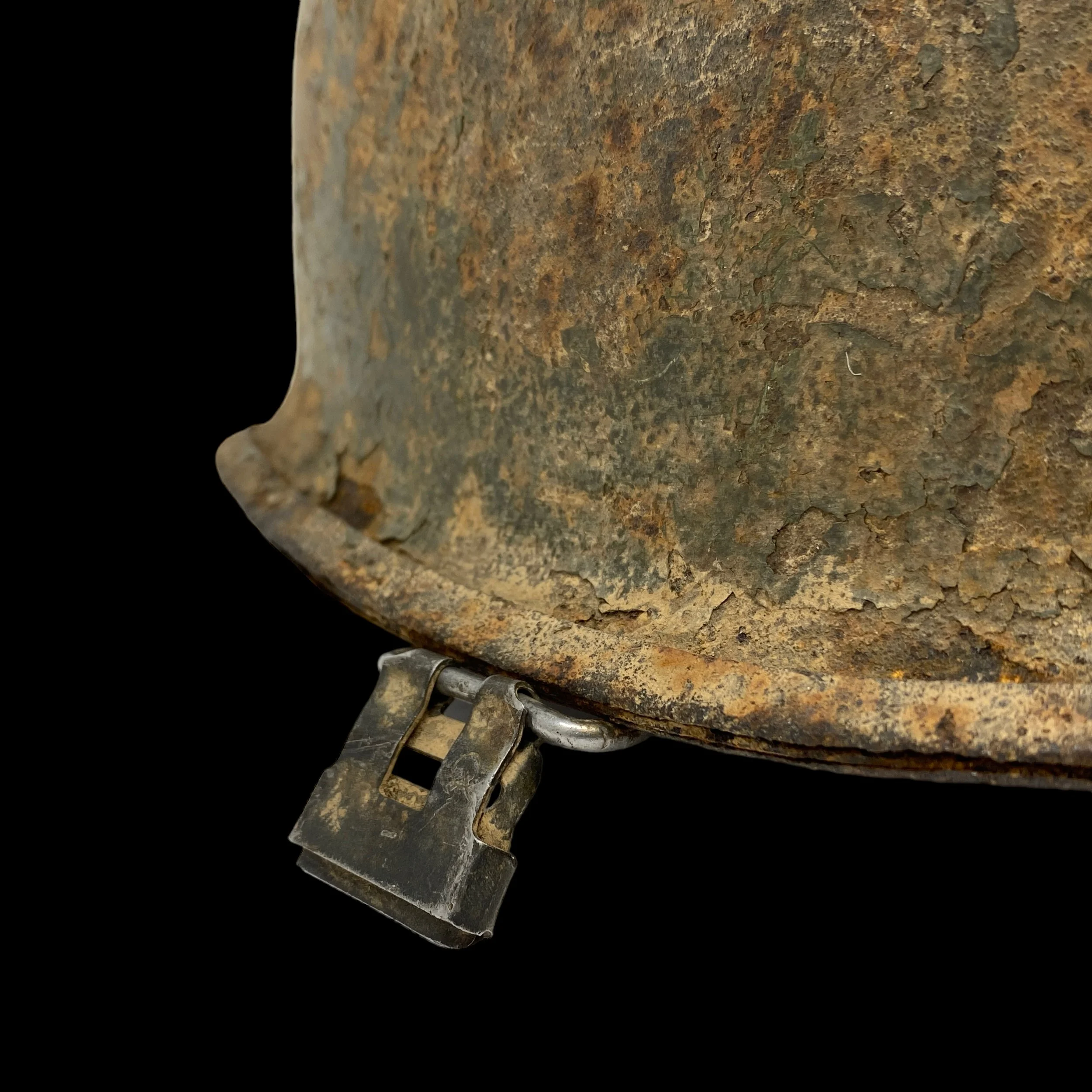VERY RARE! Vietnam War Siege of Khe Sanh "Wounded in Action" U.S. Battle Damaged Helmet Battlefield Recovered (SHRAPNEL IMPACT MARK)*

































VERY RARE! Vietnam War Siege of Khe Sanh "Wounded in Action" U.S. Battle Damaged Helmet Battlefield Recovered (SHRAPNEL IMPACT MARK)*
Comes with hand-signed C.O.A.
This incredibly rare and museum-grade Vietnam War artifact is a once-in-a-lifetime chance to own a battlefield-excavated KIA/WIA artifact from one of the bloodiest battles of the Vietnam War. What makes this battlefield-recovered helmet even more incredible is that it has a heavy/hard impact mark from shrapnel or a bullet. It is believed that this type of battlefield damaged would have wounded the U.S. soldier and would not have been a fatal KIA blow. This is a true museum artifact. Battlefield-dug Vietnam helmets with providence to a specific battle are very rare.
In late 1967 the North Vietnamese Army begins a carefully prepared operation against the U.S. Marine base at Khe Sanh, in the northwest corner of I Corps. By January 1968, between 15,000 and 30,000 Communist troops converge on the area around the base. The base, with a small airfield for resupply, guards a primary infiltration route into South Vietnam from Laos. It is the westernmost outpost of the McNamara Line, with some 6,000 Marine defenders, roughly 3,000 garrisoned at Khe Sanh itself. On January 20, North Vietnamese troops attack a U.S. patrol. Early the next morning, a main assault follows. The U.S. reinforces Khe Sanh with artillery and air support, including the massive air campaign, Operation NIAGARA. Intense fighting and artillery barrages last into April. Throughout the siege, there is some discord between General Westmoreland’s MACV headquarters and Marine Corps leadership. Complex and ill-defined command structures between MACV and III MAF lead General Westmoreland to create MACV Forward at Phu Bai, a new headquarters to oversee the battle for I Corps and bring the Marine fixed-wing aircraft under Air Force control.
This rare U.S. helmet is extremely rare and was recovered on the Battle of Khe Sanh battlefield. The Siege of Khe Sanh During the Vietnam War, US Marines established a base just 14 miles south of the DMZ near the village of Khe Sanh. In early 1968, Khe Sanh combat base was pushed to the forefront of world-wide attention as its roughly 6000 defenders were attacked by 3 North Vietnamese Army regiments (about 20,000 soldiers). During the 77 day long siege, the Marines found themselves cut off and desperately outnumbered.
One of the first engagements of the conflict took place on Hill 861, one of several small outposts surrounding Khe Sanh. Shortly after midnight on January 20th, NVA hit the hill with mortar, rocket and machine gun attacks, followed by an attack by around 300 infantry. As Kilo Company (3/26) Marines fought against overwhelming numbers, enemy soldiers infiltrated inside the defensive perimeter and close-range fighting ensued. Around 0200 the command bunker in the neighboring Hill 881 received a frantic call for help from First Lieutenant Jerry Saulsberry. “We’re being overrun! Command group is all down!” Major Matthew Caulfield, battalion Operations Officer got on the radio to calm the panicked First Lieutenant. “A Marine unit doesn’t get overrun. Now calm down and tell me what is really happening,” the major calmly said. After learning that much of Kilo company leadership had been hit, Major Caulfield replied, “Now Jerry, I know you can do this. I want you to take that ball and run with it.” After receiving this emotional support and guidance, 1 st Lieutenant Saulsberry and what was left of Kilo Company held their ground and the tide of the battle turned as American artillery and air support joined the fight, repelling the invaders. This became a theme throughout the siege of Khe Sanh. Again and again, the enemy would try to overwhelm a position, but the almost-overwhelmed marines would call in support, which would decimate the enemy attack and push them back. Though the marines were often severely outnumbered, because they were so well connected to various support elements they were usually able to overpower the enemy.
During the Khe Sanh siege, the Marine Corps employed various new methods to ensure the infantry had the support they needed to face overwhelming odds. In addition to massive fire support from nearby artillery and deadly air support, the marines also benefited from Operation Niagara (a USAF campaign of close air support that dropped 14,223 tons of bombs on the enemy in the vicinity of Khe Sanh), and Operation Igloo White (a joint electronic warfare operation in which special sensors were dropped throughout the area in order to identify NVA troop movements). Marines also created a “super gaggle” method of providing supplies and support to areas that were cut off from traditional supply routes, which coordinated air and artillery strikes nearly simultaneous to resupply missions. The marines who were in the middle of such overwhelming odds at Khe Sanh were able to survive and prevail because they were so well integrated with other resources and support.
The Message:
Like the Marines at Khe Sanh, there will be times when it may feel like your life is under siege with unfair odds stacked against you. You may feel overwhelmed by the challenges you face, or perhaps you feel isolated and weary with little hope of things getting better. It is during such trying times that a Marine’s character is defined. Though it is common for individuals to begin to emotionally withdraw when things get tough, isolation goes against all Marines have been trained to do. From the earliest days of boot camp Marines learn to rely on each other, and to reach out for support. Throughout history, and certainly in Vietnam, Marines have overcome impossible challenges by relying on each other. No matter how desperate a situation looked, there was always hope when Marines could call in support. This applies to life outside of combat as well. No matter what your challenge, or how impossible your task seems, you can face it if you call for support. Whether it comes from family, friends, religious leaders, support professionals, or other Marines, support is the key to overcoming. There is no challenge that cannot be faced and overcome when you call in support